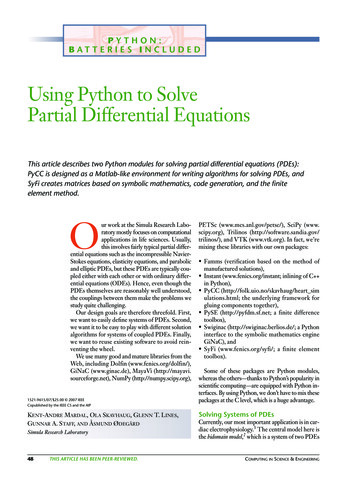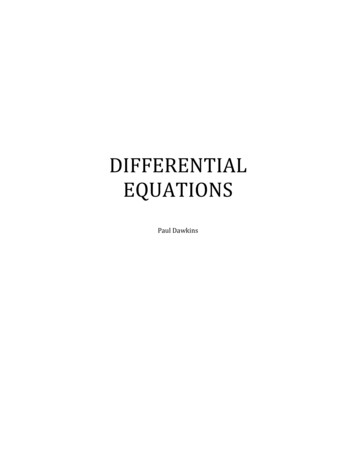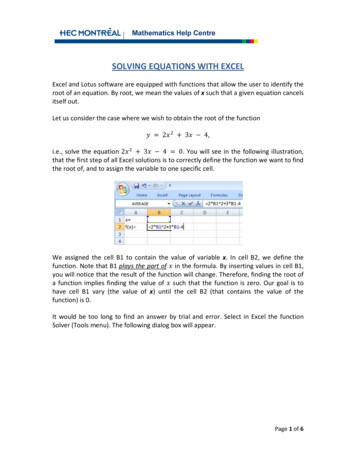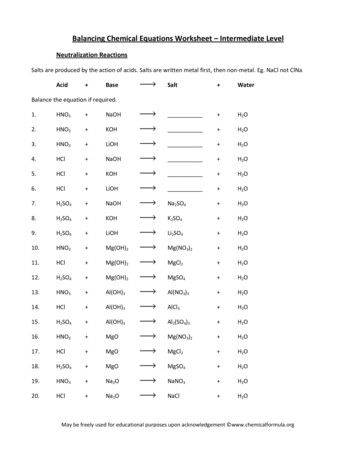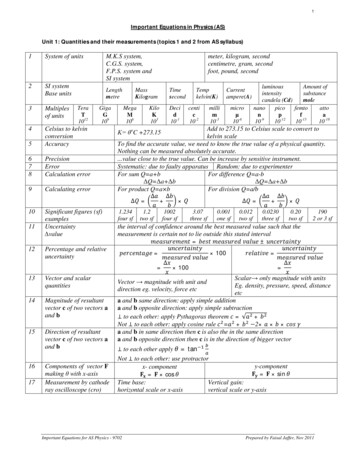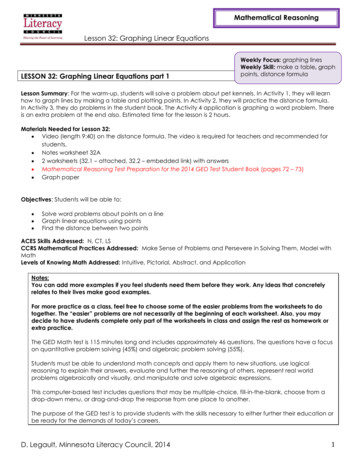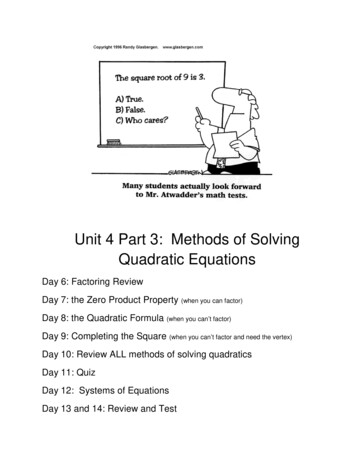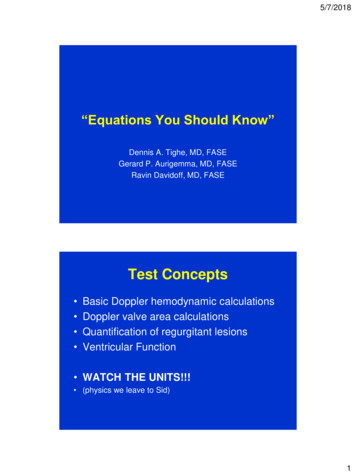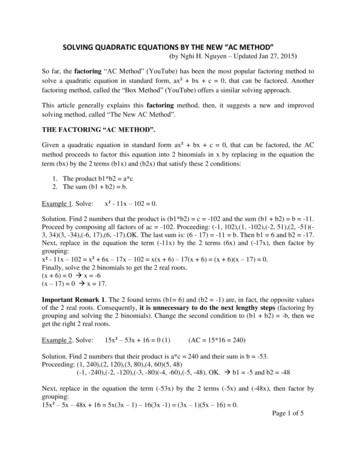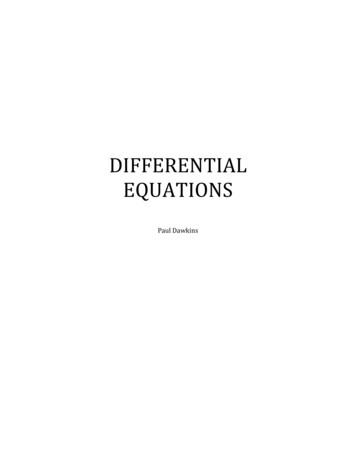
Transcription
DIFFERENTIALEQUATIONSPaul Dawkins
Differential EquationsTable of ContentsPreface . 3Outline . ivBasic Concepts . 1Introduction . 1Definitions. 2Direction Fields . 8Final Thoughts .19First Order Differential Equations . 20Introduction .20Linear Differential Equations .21Separable Differential Equations .34Exact Differential Equations .45Bernoulli Differential Equations .56Substitutions .63Intervals of Validity .71Modeling with First Order Differential Equations .76Equilibrium Solutions .89Euler’s Method .93Second Order Differential Equations . 101Introduction .101Basic Concepts .103Real, Distinct Roots .108Complex Roots .112Repeated Roots .117Reduction of Order.121Fundamental Sets of Solutions .125More on the Wronskian.130Nonhomogeneous Differential Equations .136Undetermined Coefficients .138Variation of Parameters.155Mechanical Vibrations .161Laplace Transforms . 180Introduction .180The Definition .182Laplace Transforms.186Inverse Laplace Transforms .190Step Functions .201Solving IVP’s with Laplace Transforms .214Nonconstant Coefficient IVP’s .221IVP’s With Step Functions.225Dirac Delta Function .232Convolution Integrals .235Systems of Differential Equations . 240Introduction .240Review : Systems of Equations .242Review : Matrices and Vectors .248Review : Eigenvalues and Eigenvectors .258Systems of Differential Equations.268Solutions to Systems .272Phase Plane .274Real, Distinct Eigenvalues .279Complex Eigenvalues .289Repeated Eigenvalues .295 2007 Paul Dawkinsihttp://tutorial.math.lamar.edu/terms.aspx
Differential EquationsNonhomogeneous Systems .302Laplace Transforms.306Modeling .308Series Solutions to Differential Equations . 317Introduction .317Review : Power Series .318Review : Taylor Series .326Series Solutions to Differential Equations .329Euler Equations .339Higher Order Differential Equations . 345Introduction .345Basic Concepts for nth Order Linear Equations .346Linear Homogeneous Differential Equations .349Undetermined Coefficients .354Variation of Parameters.356Laplace Transforms.362Systems of Differential Equations.364Series Solutions .369Boundary Value Problems & Fourier Series . 373Introduction .373Boundary Value Problems .374Eigenvalues and Eigenfunctions .380Periodic Functions, Even/Odd Functions and Orthogonal Functions .397Fourier Sine Series .405Fourier Cosine Series .416Fourier Series .425Convergence of Fourier Series .433Partial Differential Equations . 439Introduction .439The Heat Equation .441The Wave Equation .448Terminology .450Separation of Variables .453Solving the Heat Equation .464Heat Equation with Non-Zero Temperature Boundaries .477Laplace’s Equation .480Vibrating String.491Summary of Separation of Variables .494 2007 Paul Dawkinsiihttp://tutorial.math.lamar.edu/terms.aspx
Differential EquationsPrefaceHere are my online notes for my differential equations course that I teach here at LamarUniversity. Despite the fact that these are my “class notes”, they should be accessible to anyonewanting to learn how to solve differential equations or needing a refresher on differentialequations.I’ve tried to make these notes as self contained as possible and so all the information needed toread through them is either from a Calculus or Algebra class or contained in other sections of thenotes.A couple of warnings to my students who may be here to get a copy of what happened on a daythat you missed.1. Because I wanted to make this a fairly complete set of notes for anyone wanting to learndifferential equations I have included some material that I do not usually have time tocover in class and because this changes from semester to semester it is not noted here.You will need to find one of your fellow class mates to see if there is something in thesenotes that wasn’t covered in class.2. In general I try to work problems in class that are different from my notes. However,with Differential Equation many of the problems are difficult to make up on the spur ofthe moment and so in this class my class work will follow these notes fairly close as faras worked problems go. With that being said I will, on occasion, work problems off thetop of my head when I can to provide more examples than just those in my notes. Also, Ioften don’t have time in class to work all of the problems in the notes and so you willfind that some sections contain problems that weren’t worked in class due to timerestrictions.3. Sometimes questions in class will lead down paths that are not covered here. I try toanticipate as many of the questions as possible in writing these up, but the reality is that Ican’t anticipate all the questions. Sometimes a very good question gets asked in classthat leads to insights that I’ve not included here. You should always talk to someone whowas in class on the day you missed and compare these notes to their notes and see whatthe differences are.4. This is somewhat related to the previous three items, but is important enough to merit itsown item. THESE NOTES ARE NOT A SUBSTITUTE FOR ATTENDING CLASS!!Using these notes as a substitute for class is liable to get you in trouble. As already notednot everything in these notes is covered in class and often material or insights not in thesenotes is covered in class. 2007 Paul x
Differential EquationsOutlineHere is a listing and brief description of the material in this set of notes.Basic ConceptsDefinitions – Some of the common definitions and concepts in a differentialequations courseDirection Fields – An introduction to direction fields and what they can tell usabout the solution to a differential equation.Final Thoughts – A couple of final thoughts on what we will be looking atthroughout this course.First Order Differential EquationsLinear Equations – Identifying and solving linear first order differentialequations.Separable Equations – Identifying and solving separable first order differentialequations. We’ll also start looking at finding the interval of validity from thesolution to a differential equation.Exact Equations – Identifying and solving exact differential equations. We’lldo a few more interval of validity problems here as well.Bernoulli Differential Equations – In this section we’ll see how to solve theBernoulli Differential Equation. This section will also introduce the idea ofusing a substitution to help us solve differential equations.Substitutions – We’ll pick up where the last section left off and take a look at acouple of other substitutions that can be used to solve some differential equationsthat we couldn’t otherwise solve.Intervals of Validity – Here we will give an in-depth look at intervals of validityas well as an answer to the existence and uniqueness question for first orderdifferential equations.Modeling with First Order Differential Equations – Using first orderdifferential equations to model physical situations. The section will show somevery real applications of first order differential equations.Equilibrium Solutions – We will look at the behavior of equilibrium solutionsand autonomous differential equations.Euler’s Method – In this section we’ll take a brief look at a method forapproximating solutions to differential equations.Second Order Differential EquationsBasic Concepts – Some of the basic concepts and ideas that are involved insolving second order differential equations.Real Roots – Solving differential equations whose characteristic equation hasreal roots.Complex Roots – Solving differential equations whose characteristic equationcomplex real roots. 2007 Paul Dawkinsivhttp://tutorial.math.lamar.edu/terms.aspx
Differential EquationsRepeated Roots – Solving differential equations whose characteristic equationhas repeated roots.Reduction of Order – A brief look at the topic of reduction of order. This willbe one of the few times in this chapter that non-constant coefficient differentialequation will be looked at.Fundamental Sets of Solutions – A look at some of the theory behind thesolution to second order differential equations, including looks at the Wronskianand fundamental sets of solutions.More on the Wronskian – An application of the Wronskian and an alternatemethod for finding it.Nonhomogeneous Differential Equations – A quick look into how to solvenonhomogeneous differential equations in general.Undetermined Coefficients – The first method for solving nonhomogeneousdifferential equations that we’ll be looking at in this section.Variation of Parameters – Another method for solving nonhomogeneousdifferential equations.Mechanical Vibrations – An application of second order differential equations.This section focuses on mechanical vibrations, yet a simple change of notationcan move this into almost any other engineering field.Laplace TransformsThe Definition – The definition of the Laplace transform. We will also computea couple Laplace transforms using the definition.Laplace Transforms – As the previous section will demonstrate, computingLaplace transforms directly from the definition can be a fairly painful process. Inthis section we introduce the way we usually compute Laplace transforms.Inverse Laplace Transforms – In this section we ask the opposite question.Here’s a Laplace transform, what function did we originally have?Step Functions – This is one of the more important functions in the use ofLaplace transforms. With the introduction of this function the reason for doingLaplace transforms starts to become apparent.Solving IVP’s with Laplace Transforms – Here’s how we used Laplacetransforms to solve IVP’s.Nonconstant Coefficient IVP’s – We will see how Laplace transforms can beused to solve some nonconstant coefficient IVP’sIVP’s with Step Functions – Solving IVP’s that contain step functions. This isthe section where the reason for using Laplace transforms really becomesapparent.Dirac Delta Function – One last function that often shows up in Laplacetransform problems.Convolution Integral – A brief introduction to the convolution integral and anapplication for Laplace transforms.Table of Laplace Transforms – This is a small table of Laplace Transforms thatwe’ll be using here.Systems of Differential EquationsReview : Systems of Equations – The traditional starting point for a linearalgebra class. We will use linear algebra techniques to solve a system ofequations.Review : Matrices and Vectors – A brief introduction to matrices and vectors.We will look at arithmetic involving matrices and vectors, inverse of a matrix, 2007 Paul Dawkinsvhttp://tutorial.math.lamar.edu/terms.aspx
Differential Equationsdeterminant of a matrix, linearly independent vectors and systems of equationsrevisited.Review : Eigenvalues and Eigenvectors – Finding the eigenvalues andeigenvectors of a matrix. This topic will be key to solving systems of differentialequations.Systems of Differential Equations – Here we will look at some of the basics ofsystems of differential equations.Solutions to Systems – We will take a look at what is involved in solving asystem of differential equations.Phase Plane – A brief introduction to the phase plane and phase portraits.Real Eigenvalues – Solving systems of differential equations with realeigenvalues.Complex Eigenvalues – Solving systems of differential equations with complexeigenvalues.Repeated Eigenvalues – Solving systems of differential equations with repeatedeigenvalues.Nonhomogeneous Systems – Solving nonhomogeneous systems of differentialequations using undetermined coefficients and variation of parameters.Laplace Transforms – A very brief look at how Laplace transforms can be usedto solve a system of differential equations.Modeling – In this section we’ll take a quick look at some extensions of some ofthe modeling we did in previous sections that lead to systems of equations.Series SolutionsReview : Power Series – A brief review of some of the basics of power series.Review : Taylor Series – A reminder on how to construct the Taylor series for afunction.Series Solutions – In this section we will construct a series solution for adifferential equation about an ordinary point.Euler Equations – We will look at solutions to Euler’s differential equation inthis section.Higher Order Differential EquationsBasic Concepts for nth Order Linear Equations – We’ll start the chapter offwith a quick look at some of the basic ideas behind solving higher order lineardifferential equations.Linear Homogeneous Differential Equations – In this section we’ll take a lookat extending the ideas behind solving 2nd order differential equations to higherorder.Undetermined Coefficients – Here we’ll look at undetermined coefficients forhigher order differential equations.Variation of Parameters – We’ll look at variation of parameters for higherorder differential equations in this section.Laplace Transforms – In this section we’re just going to work an example ofusing Laplace transforms to solve a differential equation on a 3rd orderdifferential equation just so say that we looked at one with order higher than 2nd.Systems of Differential Equations – Here we’ll take a quick look at extendingthe ideas we discussed when solving 2 x 2 systems of differential equations tosystems of size 3 x 3. 2007 Paul Dawkinsvihttp://tutorial.math.lamar.edu/terms.aspx
Differential EquationsSeries Solutions – This section serves the same purpose as the LaplaceTransform section. It is just here so we can say we’ve worked an example usingseries solutions for a differential equations of order higher than 2nd.Boundary Value Problems & Fourier SeriesBoundary Value Problems – In this section we’ll define the boundary valueproblems as well as work some basic examples.Eigenvalues and Eigenfunctions – Here we’ll take a look at the eigenvalues andeigenfunctions for boundary value problems.Periodic Functions and Orthogonal Functions – We’ll take a look at periodicfunctions and orthogonal functions in section.Fourier Sine Series – In this section we’ll start looking at Fourier Series bylooking at a special case : Fourier Sine Series.Fourier Cosine Series – We’ll continue looking at Fourier Series by taking alook at another special case : Fourier Cosine Series.Fourier Series – Here we will look at the full Fourier series.Convergence of Fourier Series – Here we’ll take a look at some ideas involvedin the just what functions the Fourier series converge to as well as differentiationand integration of a Fourier series.Partial Differential EquationsThe Heat Equation – We do a partial derivation of the heat equation in thissection as well as a discussion of possible boundary values.The Wave Equation – Here we do a partial derivation of the wave equation.Terminology – In this section we take a quick look at some of the terminologyused in the method of separation of variables.Separation of Variables – We take a look at the first step in the method ofseparation of variables in this section. This first step is really the step thatmotivates the whole process.Solving the Heat Equation – In this section we go through the completeseparation of variables process and along the way solve the heat equation withthree different sets of boundary conditions.Heat Equation with Non-Zero Temperature Boundaries – Here we take aquick look at solving the heat equation in which the boundary conditions arefixed, non-zero temperature conditions.Laplace’s Equation – We discuss solving Laplace’s equation on both arectangle and a disk in this section.Vibrating String – Here we solve the wave equation for a vibrating string.Summary of Separation of Variables – In this final section we give a quicksummary of the method of separation of variables. 2007 Paul x
Differential EquationsBasic ConceptsIntroductionThere isn’t really a whole lot to this chapter it is mainly here so we can get some basic definitionsand concepts out of the way. Most of the definitions and concepts introduced here can beintroduced without any real knowledge of how to solve differential equations. Most of them areterms that we’ll use throughout a class so getting them out of the way right at the beginning is agood idea.During an actual class I tend to hold off on a couple of the definitions and introduce them at alater point when we actually start solving differential equations. The reason for this is mostly atime issue. In this class time is usually at a premium and some of the definitions/concepts requirea differential equation and/or its solution so I use the first couple differential equations that wewill solve to introduce the definition or concept.Here is a quick list of the topics in this Chapter.Definitions – Some of the common definitions and concepts in a differential equationscourseDirection Fields – An introduction to direction fields and what they can tell us about thesolution to a differential equation.Final Thoughts – A couple of final thoughts on what we will be looking at throughoutthis course. 2007 Paul Dawkins1http://tutorial.math.lamar.edu/terms.aspx
Differential EquationsDefinitionsDifferential EquationThe first definition that we should cover should be that of differential equation. A differentialequation is any equation which contains derivatives, either ordinary derivatives or partialderivatives.There is one differential equation that everybody probably knows, that is Newton’s Second Lawof Motion. If an object of mass m is moving with acceleration a and being acted on with force Fthen Newton’s Second Law tells us.F ma(1)To see that this is in fact a differential equation we need to rewrite it a little. First, remember thatwe can rewrite the acceleration, a, in one of two ways. advd 2u aORdtdt 2(2)Where v is the velocity of the object and u is the position function of the object at any time t. Weshould also remember at this point that the force, F may also be a function of time, velocity,and/or position.So, with all these things in mind Newton’s Second Law can now be written as a differentialequation in terms of either the velocity, v, or the position, u, of the object as follows.dv F (t, v )dtd 2udu m 2 F t , u, dtdt (3)m(4)So, here is our first differential equation. We will see both forms of this in later chapters.Here are a few more examples of differential equations.ay′′ by′ cy g (t )(5)d2ydy (1 y ) y 2e 5 y2dxdx( 4)y 10 y′′′ 4 y′ 2 y cos ( t )sin ( y ) 2u u x 2 ta 2u xx uttα2 3u u 1 2 x t y(6)(7)(8)(9)(10)OrderThe order of a differential equation is the largest derivative present in the differential equation. Inthe differential equations listed above (3) is a first order differential equation, (4), (5), (6), (8), 2007 Paul Dawkins2http://tutorial.math.lamar.edu/terms.aspx
Differential Equationsand (9) are second order differential equations, (10) is a third order differential equation and (7) isa fourth order differential equation.Note that the order does not depend on whether or not you’ve got ordinary or partial derivativesin the differential equation.We will be looking almost exclusively at first and second order differential equations in thesenotes. As you will see mo
Differential Equations 2007 Paul Dawkins iv http://tutorial.math.lamar.edu/terms.aspx Outline Here is a list

